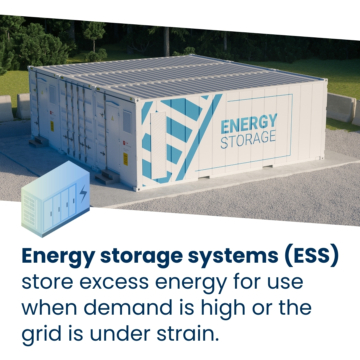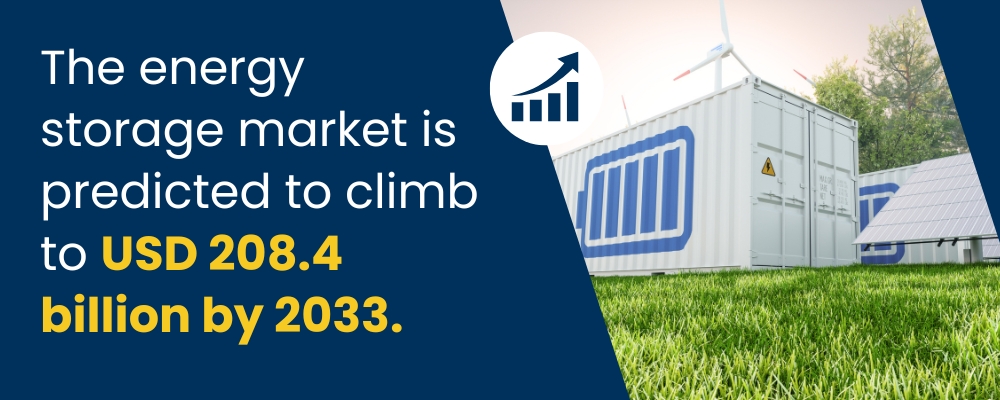Power Shift: What Electrical Pros Should Know About ESS
The future of energy isn’t just renewable—it’s flexible. As the grid evolves to meet the rising demand for clean power, energy storage systems (ESS) are emerging as the critical link between generation and reliability. With battery storage capacity projected to triple by the end of 2025—reaching 30.0 gigawatts—ESS are no longer optional. They’re becoming the backbone of a resilient, decentralized energy future.
As renewable energy sources like solar and wind continue to gain momentum, the ability to store energy and deliver it on demand is transforming how buildings and facilities are powered. This shift represents a growing opportunity for electricians and electrical contractors to expand their services and stay ahead of industry trends.
Learn more about the growth of energy storage systems and how they affect the electrical sector.
What is an ESS? 
The rise of renewable energy, particularly solar and wind, has created a more dynamic but less predictable power grid. Energy storage systems (ESS) bridge that gap by storing excess energy when production is high and releasing it when demand surges or the grid falters. ESS capture and hold energy for later use. They are employed to meet energy supply and demand, especially with renewable sources like solar and wind.
ESS provide reliable solutions for:
- Balancing intermittent renewable energy sources
- Reducing peak demand charges
- Providing backup power during outages
- Supporting energy independence in smart buildings and microgrids
Why is Energy Demand On the Rise?
The energy storage market is predicted to climb to USD 208.4 billion by 2033. Why? Today’s power grid is more dynamic than ever, especially in high-growth regions like the Pacific Northwest. The area has become a hotspot for data center and warehouse expansion—two sectors heavily demanding electrical infrastructure.
As more tech-driven buildings come online, energy demand continues to rise. Energy storage systems (ESS) help ensure a reliable power supply—even when the sun isn’t shining or demand peaks.

What are the Advantages of ESS?
Energy storage systems play a crucial role in supporting the integration of renewable energy. By storing power for extended periods and delivering it on demand, these systems help manage weather grid instability and outages, making electrical professionals an integral part of the industry’s progress.
- U.S. data centers are expected to increase electrical consumption by 160% by 2030. With over 200 such centers in Washington and Oregon alone, energy resilience will be crucial to meet energy demand.
- Heating, cooling, and lighting account for nearly half of a warehouse’s energy consumption. Utilizing energy storage to mitigate demand peaks can significantly reduce operational costs and enhance sustainability. The opportunity for electricians to implement ESS in these spaces is massive.
- Smart buildings utilize sensors, automation, and Internet of Things (IoT) devices to optimize everything from lighting to HVAC systems. ESS complement these technologies by ensuring a consistent power supply, allowing buildings to operate efficiently.
Electrical Professionals Can Stay Ahead of Industry Changes
For electrician professionals looking to stay competitive and future-ready, energy storage represents a valuable opportunity to diversify their skills and grow their business.
- Get certified in energy storage installation and safety.
- Learn about solar, wind, and microgrid integration.
- Stay updated on local codes and utility programs.
- Explore smart building automation platforms.
- Offer clients energy audits and ESS recommendations.
For electricians and electrical contractors, the ESS trend isn’t just a technical shift—it’s a career opportunity. Those who understand ESS technology, renewable integration, and smart energy management will be well-positioned to lead the way in 2025 and beyond.
Take the Next Step With NECA-IBEW Local 48
Since 1913, the NECA–IBEW Local 48 partnership has been dedicated to strengthening Oregon and Washington’s electrical sector. Visit our membership page to learn more about benefits and opportunities.
SIGN UP FOR OUR NEWSLETTER


